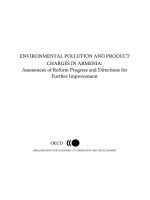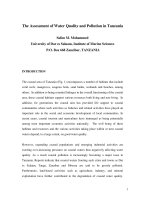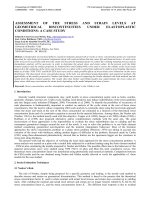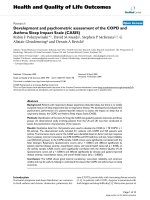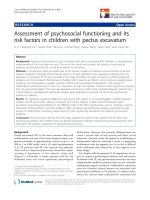Assessment of blue carbon and carbon trading
Bạn đang xem bản rút gọn của tài liệu. Xem và tải ngay bản đầy đủ của tài liệu tại đây (7.91 MB, 75 trang )
MINISTRY OF EDUCATION AND TRAINING
NHA TRANG UNIVERSITY
___________________________
BEATRICE NJERI OBEGI
ASSESSMENT OF BLUE CARBON AND CARBON TRADING; A CASE
STUDY OF GAZI BAY MANGROVE FOREST, KENYA
MASTER THESIS
KHANH HOA – 2018
MINISTRY OF EDUCATION AND TRAINING
NHA TRANG UNIVERSITY
___________________________
Beatrice Njeri Obegi
Assessment of Blue Carbon and Carbon Trading; A Case Study of Gazi
Bay Mangrove Forest, Kenya
MASTER THESIS
Code:
Marine Ecosystem Based Management and
Climate Change
58CH161
Topic allocation Decision
1006/QD-DHNT
Decision on establishing the
Committee:
Defense date:
Supervisors:
5th June 2018
Major:
PROF. CURTIS M. JOLLY
DR. GEORGE OGENDI
Chairman: Prof. Ngo Dang
Nghia
Faculty of Graduate Studies:
KHANH HOA – 2018
UNDERTAKING
By the candidate:
I declare that the thesis entitled Assessment of Blue Carbon and Carbon
Trading; A Case Study of Gazi Bay Mangrove Forest, Kenya is my original
work. The work has not been presented elsewhere for assessment until the time this
thesis is submitted.
14th June 2018
Beatrice Njeri Obegi
iii
DEDICATION
This thesis is a special dedication to my husband Hezron, who accepted to look after
the children during my study leave.
iv
ACKNOWLEDGMENTS
First and foremost, I wish to sincerely thank the Norhed Program, (Tomso University,
and Nha Trang University) for giving me the golden opportunity to study Marine
Resource Ecosystem Based and Climate Change.
I hereby express my heartfelt gratitude to Professor Curtis M. Jolly (Auburn
University), Dr. George Ogendi (Egerton University) and Professor Kim Anh Thi
Nguyen (Nha Trang University) and professor Genevieve Mwayuli of Catholic
university of Eastern Africa. I appreciate every second you took to direct, comment
and critique my work. These comments enabled me to gain confidence and to
complete my thesis in time.
I also want to acknowledge the Kenya Marine and Fisheries Research Institute for
accepting my research activities their institute. Special thanks to Dr. James Kairo for
facilitating my attachment in KMFRI, Gazi sub-station for data collection to
accomplish my objectives.
It was an immense pleasure to work with Mikoko Pamoja staff Ann Wanjiro,
Mwamba and KMFRI technicians, Alfred Obinga and team. I give thanks to Athman
who tirelessly led me to houses in the two villages.
Special thanks to the Gazi Women Boardwalk for assisting me and contributing to the
survey.
I would not forget to acknowledge the local residents of Gazi for their cheering mood
as I was conducting the household survey.
May God bless you all.
Nha Trang University, May 2 2018
Beatrice Njeri Obegi
v
Table of Contents
UNDERTAKING ............................................................................................................... iii
DEDICATION.................................................................................................................... iv
ACKNOWLEDGMENTS ................................................................................................... v
ACRONYMS...................................................................................................................... ix
LIST OF TABLES............................................................................................................... x
LIST OF FIGURES ............................................................................................................ xi
LIST OF GRAPHS ............................................................................................................ xii
LIST OF EQUATIONS .................................................................................................... xiii
LIST OF UNITS ................................................................................................................ xv
KEY DEFINITIONS ........................................................................................................ xvi
ABSTRACT .................................................................................................................... xvii
BACKGROUND OF THE STUDY ............................................................................... xviii
CHAPTER 1 ........................................................................................................................ 1
1.0 INTRODUCTION...................................................................................................... 1
1.1 PROBLEM STATEMNT.......................................................................................... 3
1.2: OBJECTIVES OF THE STUDY ............................................................................. 4
1.2.1 BROAD OBJECTIVES ....................................................................................... 4
1.2.2 SPECIFIC OBJECTIVES ................................................................................... 4
CHAPTER 2 ........................................................................................................................ 5
LITERATURE REVIEW .................................................................................................... 5
2.1 THE CONCEPT OF BLUE CARBON AND CARBON TRADING ....................... 5
2.2 CAUSES OF MANGROVE FOREST REDUCTION .............................................. 7
2.2.1 Overexploitation .................................................................................................. 7
2.2.2 Habitat Destruction .............................................................................................. 7
2.2.3 Urbanization and Agriculture .............................................................................. 7
2.3 CONSEQUENCES OF BLUE CARBON DEPLETION .......................................... 7
2.3.1 Loss of Fishery..................................................................................................... 7
2.3.2 Loss of Biodiversity ............................................................................................. 7
2.3.3 Climate change .................................................................................................... 8
2.4 AIMS OF MAPPING BLUE CARBON AND CARBON TRADING ..................... 8
vi
2.4.1. Forest management ............................................................................................. 8
2.4.2 Carbon Credits ..................................................................................................... 9
2.5. A REVIEW OF BLUE CARBON AND CARBON TRADING ............................... 11
2.5.1 Socioeconomic Impacts of Carbon Trading on Gazi Bay ................................. 11
2.5.2 Conceptual Model .............................................................................................. 11
2.5.3 Forest Structure .................................................................................................. 13
2.5.4 Carbon Sequestration ......................................................................................... 13
2.5.5 Carbon Trading .................................................................................................. 14
2.6 MERITS OF MANGROVE FOREST AND CARBON TRADING ...................... 14
2.7 CARBON TRADING REVIEW ............................................................................. 15
2.7.1 Income ............................................................................................................... 15
2.7.2 Employment ....................................................................................................... 15
2.7.3 Tourists Attraction ............................................................................................. 15
2.7.4 Boardwalk Cash ................................................................................................. 15
2.7.5 Fish Landings ..................................................................................................... 15
CHAPTER 3 ...................................................................................................................... 16
METHODS AND METHODOLOGY .............................................................................. 16
3.1 Study Area ................................................................................................................ 16
3.1.2 Biophysical Characteristics of the Study Area .................................................. 18
3.1.3 Social- Economic ............................................................................................... 19
3.2 METHODS OF SAMPLING AND DESIGN ......................................................... 19
3.2.1 Social Survey ..................................................................................................... 19
3.2.3 Tradable Carbon Credits .................................................................................... 20
3.2.2 Forest Structure .................................................................................................. 20
3.4 DATA ANALYSIS .................................................................................................. 20
CHAPTER 4 ...................................................................................................................... 23
RESULTS AND DISCUSSION ........................................................................................ 23
4.1 Social economic status of Gazi community ............................................................. 23
4.1.1 Number of people interviewed and Age ............................................................ 23
4.1.2 Gazi community Total Income .......................................................................... 24
4.1.3 Occupation activities.......................................................................................... 25
vii
4.1.4 Community Participation to protect Blue Carbon ............................................. 26
4.1.5 Importance of Conservation Projects................................................................. 26
4.1.6 State of Gazi Mangroves ................................................................................... 27
4.1.7 Value of Mangroves........................................................................................... 28
4.1.8 CARBON TRADING EVALUATION PROMETHE MODEL ....................... 28
........................................................................................................................................ 29
4.4.2 Promethee I ranking ........................................................................................... 29
........................................................................................................................................ 30
4.4.3 Promethee II ranking ......................................................................................... 30
........................................................................................................................................ 31
4.4.4 GAIA Brain........................................................................................................ 31
........................................................................................................................................ 32
4.2 FOREST STRUCTRURE ........................................................................................ 32
4.2.1 Mangrove tree species and total density ha-1 ..................................................... 32
4.2.3 Diameter classes and Stems ha-1 ........................................................................ 34
4.2.4 Mean height, Basal area and Complexity index ................................................ 34
4.2.5 Density, Frequency, Dominance and Important Value ..................................... 35
4.2.6 TRADABLE CARBON STOCKS AND CREDITS ......................................... 36
4.2.7 Carbon stocks (benefits) .................................................................................... 37
CHAPTER 5 ...................................................................................................................... 39
CONCLUSION AND RECCOMENDATIONS ............................................................... 39
REFERENCES .................................................................................................................. 42
APPENDICES .................................................................................................................... A
viii
ACRONYMS
PES
Payment for Ecosystem Services
KFS
Kenya Forest Services
ACES
Association for Coastal Ecosystem Services
CFA
Community Forest Association
ESPA
Ecosystem Services for Poverty Alleviation
GOGACFA
Gogoni Gazi Community Forest
GHE
Greenhouse Gazi Emission
KCDP
Kenya Coastal Development Project
MPCO
Mikoko Pamoja Community Organization
GAGOFA
Gazi-Gogoni Community Association
KMFRI
Kenya Marine and Fisheries Research Institute
MPSG
Mikoko Pamoja Steering Group
PDD
Project Design Document
PVC
Plan Vivo Credits
MP
Mikoko Pamoja
BAU
Business as usual
ix
LIST OF TABLES
Table 1 1: Benefits from Mangroves .................................................................................. 2
Table 4. 1: Detailed values of option and criteria............................................................. 19
Table 4 2: Contingent Valuation Analysis ....................................................................... 28
Table 4. 3: Showing Net Phi ............................................................................................. 29
Table 4. 4: Mangrove species diameter class ................................................................... 33
Table 4. 5: Mangrove tree structure values ...................................................................... 35
Table 4. 6: Relative density, frequency and dominance of mangrove species ................. 36
Table 4 7: Carbon credit benefits ..................................................................................... 37
x
LIST OF FIGURES
Figure 2 1: Showing the replanted forest to promote Carbon Trading in Gazi Bay .......... 9
Figure 2 2: Showing the conceptual model of the research study .................................... 12
Figure 3 1: Showing the Map of the study Area .............................................................. 17
Figure 3 2: Showing Data collection at study Area.......................................................... 21
Figure 3 3: Showing Point of Measurement of tree ......................................................... 22
xi
LIST OF GRAPHS
Graph 3 1:
Showing rainfall distribution in Gazi bay. Source mathijs et al., 1999 ........................ 18
Showing temperature distribution in Gazi Bay. Source Mathijs et al., 1999 ............... 18
Graph 4. 1: Showing Frequency and Age Class of the Respondent............................. 24
Graph 4. 2: Showing Income of Respondent................................................................ 24
Graph 4. 3: Type of Houses of Gazi people ................................................................. 25
Graph 4. 4: Showing Occupation of the respondent .................................................... 25
Graph 4. 5: Community Participation promoting carbon Trading ............................... 26
Graph 4. 6: Showing importance of Carbon Trading ................................................... 27
Graph 4. 7: Describing status of Mangrove before Restoration ................................... 27
Graph 4. 9: Showing Promethee Rainbow ................................................................... 29
Graph 4. 10: Showing Promethee Partial Ranking ....................................................... 30
Graph 4. 11: Showing Promethee Complete Ranking ................................................. 31
Graph 4. 12: Showing the GAIA Brain ........................................................................ 32
Graph 4. 8: Showing the Diameter class and stem density .......................................... 34
xii
LIST OF EQUATIONS
Equation 3 1: Showing equation for Total Stand BA ...................................................... 21
Equation 3 2: Showing Stem Density .............................................................................. 21
Equation 3 3: Showing Relative Density ......................................................................... 21
Equation 3 4: Showing Relative Frequency..................................................................... 21
Equation 3 5: Showing Relative Dominance ................................................................... 21
xiii
LIST OF APPENDIX
APPENDIX 1: GAZI BAY SOCIAL-ECONOMIC SURVEY QUESTIONAIR
SHEET- DATE: 15/ 08/ 2017 ....................................................................................... A
Appendix 2 MANGROVE VEGETATION DATA SHEET ........................................ B
Appendix 3 .................................................................................................................... C
Forest Structure Data Collection Western Block .......................................................... C
Forest Structure Data Collection Eastern Block ............................................................ C
xiv
LIST OF UNITS
Ha
hectare
Kg
Kilogram
M
Meter
L
Litre
M2
Square Meter
$
Dollar
%
Percentage
Ha-1
Per Hectare
Km2
Square Kilometer
Yr-1
Per year
Ha-1 yr-1
Per hectare Per year
KES
Kenya shillings
°C
Degrees centigrade
Mm/yr
Millimeter Per year
tCO2
Total Carbon dioxide
Cm
Centimeter
∑
Sum
IV
Important Value
BA
Basal Area
DBH
Diameter at Breast Height
CI
Complexity Index
xv
KEY DEFINITIONS
Blue Carbon:
Carbon captured by living organisms in oceans which is stored in the form of biomass
and sediments from mangroves, salt marshes and sea grasses.
Carbon Credits:
Tradable certificates or permit representing the right to one ton of carbon dioxide or
the mass of another greenhouse gas with a Carbon dioxide equivalent to one ton of
Carbon dioxide tCO2.
Households:
Consists of one or more people who live in the same dwelling and also share at meals
or living accommodation, and it may consists of a single family or some other group.
Mangroves:
Refers to; assemblage of tropical trees and shrubs that grows in the intertidal zone.
Livelihoods:
A source of income, assets or resources for sustains life.
PROMETHEE:
Promethee stands for Preference Ranking Organization METHod for Enrichment of
Evaluations.
GAIA:
GAIA stands for Graphical Analysis for Interactive Aid.
xvi
ABSTRACT
It is beyond doubt that blue carbon has been overexploited and is now threatening the
lives of the coastal communities. The carbon trading is important into restoring back
the lost mangroves. Mangroves, salt marshes and sea grass represent a portion of blue
carbon. In this study I aimed at assessing the blue carbon special attention to
mangroves and carbon trading specifically; social economic effects of carbon trading,
the forest structure and total carbon benefits that can be sold. The social economic
characteristics of households conducted through face to face interviews by
administering questionnaires, showed that that out of over 200 houses interviewed for
51% were female while 49% were male. The findings show that the major livelihood
activities of the community were was business, farming and fishing. The study
revealed that the carbon trading have both primary and secondary benefits to the
community and so the community engage in various activities such as replanting,
cleaning to conserve the natural resource for sustainability .The forest structure was
determined by taking tree measurements of diameter at breast height (DBH), the
canopy height and the tree species in a tree belt using 10m by 10m plots on the tree
stretched belts in the conserved area. The results indicated that the stem density of
3839 stems ha-1 and basal area was 12.3 stems ha-1. The total carbon benefits tCO2
was Calculated using PDD models of mikoko pamoja project which has a total of
tCo2 2023 equivalent to $ 12 128. Carbon trading impact to the livelihoods was
assessed using the promethee model Valuation, the results showed that the carbon
trading has improved the lives of the community by providing freshwater to the
households, improved in health care and created employment improved in transport
system. The promethe model used to rank the last four years of conserving the blue
carbon and the impacts of carbon trading ranked the options from the best to the
worst. The option for empowerment received the lowest income while Management
was the best. The results justified the implementation of conservation and restoration
programs especially Mp and has encouraged carbon trading.
KEY WORDS: Mangroves; Carbon Trading; Forest Structure; Promethee
xvii
BACKGROUND OF THE STUDY
Mangrove conservation has been a major focus on most mitigation programs
purposely in helping degradation and depletion. Mangrove ecosystem together with
salt marshes and sea grass makes blue carbon composition. The forest and the carbon
trading emerge an important resource for the communities around the coastal regions,
and the best in carbon sequestering as well. The Carbon trading has significant
benefits including helping in reducing global warming (Nijbroek 2014).Usually the
forest acts as carbon sinks through trapping carbon dioxide from the atmosphere
(Murdiyarso et al. 2009). In addition the carbon trading has unique secondary benefits
for the community besides the regulating the temperatures. Since overexploitation
threatens their existence now and in future, conservation programs and reforestation
has shown positive efforts to reclaim the lost mangroves as well as helping the
community to develop, in addition Mangrove forest can attain immense biomass and
height, and the size of tropical rainforest, that can be helpful also to be reduce climate
change and mitigation (Alongi 2009) this programs provides the opportunity to utilize
the mangrove ecosystem sustainably. This research aimed at studying the
socioeconomic effects of the carbon trading on Gazi bay community forest structure
and the carbon benefits for trading. Carbon trading in Gazi Bay has been the best
business that that taps income from donors, termed as free cash in air and these has
completely changed the lifestyle of Gazi people. Little information has been revealed
about the structure and the density of this forest and how the sequestered carbon sold,
and how the how the community has benefited. The study was to understand the blue
carbon and carbon trading in Gazi. The specific objectives of the study were to (a)
assess the socioeconomic effects of the carbon trading on Gazi bay community (b) To
assess the forest structure of Gazi bay mangrove forest and calculate carbon stocks.
Through a social survey to carry out face to face
interviews on 100 households of
each village. Mangrove forest structure data was obtained by marking10 quadrants
with blocks of 10m by 10m to achieve objective two. Carbon Credits was achieved
by` calculating the number of hectares (ha) and blocks and then multiplying by dollars
and get the income. Using Various options and named criteria, promethee was used to
rank the best of all criteria. The thesis consist of Chapter one as the introduction
xviii
Chapter 2 discusses the literature review, Chapter three consists of the methods and
methodology, Chapter four consists of the research findings and discussion. Chapter
five contains the conclusion and recommendation.
xix
CHAPTER 1
1.0 INTRODUCTION
Blue Carbon incorporates mangroves, salt marshes and sea grass. The blue carbon that is
mainly focused in this paper is Mangrove forest in Gazi Bay, it is normally found in
tropical and subtropical coastline. There are many species of mangroves that make more
than one hundred species, and the world largest mangroves is in Asia, which makes 68
million hectares, followed by Africa with 20% (Huff & Tonui 2017). In Kenya mangroves
occupy a total of 54000 hectares that run across Kenyan coastline according to Kenya
Forest Service (KFS). Mangrove conservation is very important in fighting Climate Change
and can also prevent disasters and risks to the coastal communities as well as stopping
storm surges and soil erosion (Nijbroek & Basu 2014). Community based conservation
programs that started conserving natural forest and replanting of 4000 tree each year has
enhanced carbon trading in Gazi Bay. The carbon stocks are sold to the international buyers
and other private organization, Payment of Ecosystem Services (PES) (Plan Vivo 2013).
Kenya coastal development project (KCDP) constructed a watchtower to enhance
surveillance and monitoring of the conserved area and through carbon trading the
community earns income every year. For decades now it has been noted that lack of
community participation and inputs in respect to management, poverty levels amongst the
community, lack of awareness on mangrove uses (table 1.1) and importance, and lack of
alternative livelihoods are major obstacles to the wise use of mangroves (Bouillon et al.
2008).
1
Table 1. 1: Benefits from Mangroves
Species Name
Use
Avicinnea marina
Firewood, Fence, Chairs, Charcoal, boat crushing mortar
Bruguirera
gymnorrhiza
Commercial firewood, charcoal roofs, oars, handcart handles, axe
handles, bee hives
Ceriopes tagal
Construction poles, paddles, Oars commercial firewood, fishing traps
Lumnitzera racemosa
Medium quality commercial firewood and charcoal
Rhizophora
mucrunata
Construction poles, high quality commercial charcoal, commercial
firewood, fencing traps
Xylocarpus
Mollucensis
Quality timber for construction and furniture, charcoal
Xylocarpus granatum
High quality timber for bed construction, window, door frames, medium
commercial charcoal and firewood
Heritiera Littoralis
Charcoal, firewood, building wood
Source:(Bosire et al. 2008)
The replanting and conserving mangroves in specific areas started in 2013 and its aim was
to plant trees on an area of 0.4 ha every year and conserve the natural forest of 107 ha,
Knowledge on the status of blue carbon and carbon business about the achievements is
required to help in its sustainability. The purpose of this study is to provide information to
the stakeholders for decision making and planning. Most of the studies have been focusing
on the degradation and exploitation of the mangrove forest. There is little knowledge and
data on the mitigation programs, and other efforts made to restore and make sure mangrove
forests are saved from extinction (Bunt 1996). Mikoko pamoja works together with the
association for coastal Ecosystem Services (ACES) (a registered Scottish charitable
Incorporated Organization SCIO, REC SC043978) under the laws of Scottish government
(Plan Vivo 2013). This agreement concerns initiation of a carbon based forest management
project, involving forest conservation measures for the reduction of unsustainable and
destructive forest use and facilitating the investigation of long-term sequestration of carbon
2
dioxide through community based management, implemented through a partnership
between MPCO and ACES. Revenues generated by these activities will be used for social
and environmental improvements for the people of Gazi Bay. The goal of this paper was
map replanted and conserved tress and carbon trading, further because of the benefits of
carbon trading in Gazi, there is a lot of attraction both local, regional and globally because
of its achievements and it has gained an equator price by UNDP for improving livelihoods
and poverty alleviation. Using Promethe valuation model to analyse the impacts of carbon
trading in the community, the proposed objectives were to study (a) to study the socialeconomic effects of carbon trading (b) to show how the forest structure of Gazi and
calculate the carbon credits that are tradable.
1.1: PROBLEM STATEMNT
From the previous studies mangroves were estimated to be 18.1 million Km2 worldwide
but a more recent estimate indicate that the figure may be 15 million Km2 (FAO 1994).
Globally according to the blue carbon manual, approximately 70% of mangroves have been
lost (McLeod et al. 2011). When it comes to regional almost more than 50% of mangroves
have been degraded and lost (Godoy & Lacerda 2015). This study purposely intends to
answer research questions that are in line with the government’s agenda fourteen that is
specifically stipulated in the Sustainable Development Goals (SDSs) on life below water.
The research entails in providing information on conserving and sustainable use of the
oceans, seas and marine resource for sustainable development. A study done by Landsat
Ocean Coast management and Kenya Marine and Fisheries Research Institute showed that
from 2000 to 2010 mangroves loss in Kenya totaled 1340 hectares. Numerous policies,
coastal management strategies and tools designed for conserving and restoring coastal
ecosystems that were developed and implemented should be evaluated. Conservation
programs managed by MP and Kenya Marine and Fisheries implemented to mitigate
climate change and to redeem the dying mangroves. There is therefore need to establish and
investigate the community livelihoods and the forest structure and cover, and this
information is required by the decision makers and the government for poverty alleviation,
food security and nutrition.
3
The purpose of the study is to provide information on the status of blue carbon and carbon
trading that is required by the government that is categorically mentioned in the Sustainable
Development goals which is described as the conservation of life below water.
The
information will reveal the challenges, impacts and setbacks on mangrove conservation and
utilization of this forest. The study will shed more impacts of carbon trading which is
carried out by MP, to improve the women, children and youth empowerment and most
important is how it has improved the structure and composition of the Gazi mangrove
forest. This information is mainly useful in providing insights of current status of blue
carbon and carbon trading for better facilitation of wise decision making and
implementation of new sound management options and remedies.
Mikoko Pamoja (MP) project is a Swahili word meaning Mangroves together that was
implemented in 2013 to restore the lost mangroves, and reports indicate that the community
has gained a lot in terms of education, freshwater, employment and improved two schools.
This MP project is the one responsible for carbon trading.
1.2: OBJECTIVES OF THE STUDY
1.2.1: BROAD OBJECTIVES
The main object of this study was to assess the blue carbon and carbon trading at Gazi Bay
mangrove Forest, Kenya.
1.2.2: SPECIFIC OBJECTIVES
This paper has attempted:
1. To assess the socioeconomic effects of the carbon trading on Gazi bay
community
2. To assess the forest structure of Gazi bay mangrove forest and calculate the
amount of blue carbon sequestered by the study forest
4
CHAPTER 2
LITERATURE REVIEW
2.1. THE CONCEPT OF BLUE CARBON AND CARBON TRADING
Blue carbon is the term for carbon captured by Worlds Ocean and coastal ecosystems. As
mentioned above the blue carbon in coastal ecosystems focuses more on mangroves, salt
marshes and sea grass. Mangroves are a group of trees and shrubs that live in the coastal
intertidal zone; Sea-grass is defined as a grass like plant that lives in or close to the sea
(Kauffman & Donato 2012). A tidal marsh is a wet land regularly inundated by backing up
of adjoining streams through tidal actions. These ecosystems sequester and stores large
quantities of blue carbon in both plants and sediments.
The coastal blue carbon ecosystems are valued because of their capacity to address climate
change and may also secure social economic and environmental problems. Carbon trading
is the process of buying and selling permits and credits to emit Carbon dioxide. It is
important to understand carbon trading. It is a tool to help in efforts to slow climate change
(Ruddell et al. 2006). While an emission trading is a form emission trading that specifically
targets carbon and it currently constitute the bulk of emissions trading. Many countries
utilize this form of permit trading in order to meet their recommended specified by Kyoto
protocol. Many people have increasingly involved in market forces as the best tool in
responding to the extreme environmental problems (Soontornwong 2006). This has
attracted concepts and strategies that link markets to community conservation programs
which have posed popularity and diversified
Mangroves as one of the highest composition of blue carbon is defined as a salt tree that
grow in tidal waters of (Kauffman & Donato 2012) sub-tropical and tropic coastlines
Mangrove trees form forests of salt-tolerant species with complex food webs and ecosystem
dynamics which make them a carbon-rich biome, and valuable Blue Carbon among
estuaries, sea grass beds, and coral reefs (R. Iii & L. Flynn 2009). Mangrove forests also
produce carbon stocks which can be converted into Carbon Credits that can be involved in
Carbon Trading in the Carbon Markets (McLeod et al. 2011) Mangrove forest provides an
array of provision and regulatory services. The forest is found in sheltered estuaries and
5
lagoons in sub-tropic and tropics. They are adapted to live in tidal environment and form
true eco-ton. The role of mangroves forest and other carbon sinks associated with land use
changes is recognized in international treaties especially in United Nations Framework
convention on Climate Change (UNFCCC) 1992 earth summit (Ruddell et al.
2006).Mangrove vegetation covers roughly 170000 square kilometers of the earth’s surface
(I. Valiela et al. 2001). In a global view countries containing mangroves have increasingly
recognized the benefits provided by mangrove ecosystem(H. Carter et al. 2015). Global and
regional declines should be addressed and arrested to curb the possibility of having a world
without mangroves predicted within 100 years. In Kenya mangrove covers approximately
54000 ha of land and consists of 10 mangrove species with dominant species Rhizophora
mucrunota and Ceriops tagal making 70% of mangrove formation (J. Hoberg 2011).
Previous study by (UNEP 2011) have shown the total area of Gazi bay is 1600 Ha (Bunt
1996) and all the nine species of mangroves cover an area of 600 Ha, and 1000 Ha has no
mangroves (Dahdouh-Guebas & Satyanarayana 2012) .Mangroves play a number of
functions such as helping in protecting coral reefs, sea grass beds and shipping lanes by
upland runoff sediments, control soil erosion and protect coastal communities against
effects of strong water currents, waves and strong wind (FAO 2017). Gazi community
Cherish the value of mangroves from high fish catch, timber production, building poles,
charcoal, other uses such as boat masts and fish traps, boat construction, floaters for fishing
nets; they also use mangroves for producing furniture and for honey farming. Most studies
describe how mangroves support the conservation of biological diversity by providing
habitats, spawning grounds, nurseries and nutrients for a number of animals. Most reptiles,
several amphibians, birds and a range of mammals e.g. Tiger including other several
endangered species are under the mercy of mangroves. In addition mangrove ecosystems
have been used as aquaculture farming (e.g. oysters and mussels) and as pond culture of
shrimps(Dahdouh-Guebas & Satyanarayana 2012). (FAO 2007)Mangrove forests as blue
carbon play a major role in carbon sequestration and carbon storage in reducing impacts of
climate change. The role of carbon storage in mangroves is often not clear and in achieving
huge cuts of in GHG emissions we should capture and store CO2 (D.Along 2012).
6


